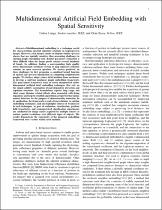JavaScript is disabled for your browser. Some features of this site may not work without it.
- ResearchSpace
- →
- Research Publications/Outputs
- →
- Journal Articles
- →
- View Item
| dc.contributor.author |
Lunga, D

|
|
| dc.contributor.author |
Ersoy, O

|
|
| dc.date.accessioned | 2014-02-19T07:58:30Z | |
| dc.date.available | 2014-02-19T07:58:30Z | |
| dc.date.issued | 2013-06 | |
| dc.identifier.citation | Lunga, D and Ersoy, O. 2013. Multidimensional artificial field embedding with spatial sensitivity. IEEE Transactions on Geoscience and Remote Sensing, vol. 52(2), pp 1518-1532 | en_US |
| dc.identifier.issn | 0196-2892 | |
| dc.identifier.uri | http://ieeexplore.ieee.org/stamp/stamp.jsp?tp=&arnumber=6532393 | |
| dc.identifier.uri | http://hdl.handle.net/10204/7233 | |
| dc.description | Copyright: 2013 IEEE Xplore. This is the post print version of the work. The definitive version is published in IEEE Transactions on Geoscience and Remote Sensing, vol. 52(2), pp 1518-1532 | en_US |
| dc.description.abstract | Multidimensional embedding is a technique useful for characterizing spectral signature relations in hyperspectral images. However, such images consist of disjoint similar spectral classes that are spatially sensitive, thus presenting challenges to existing graph embedding tools. Robust parameter estimation is often difficult when the image pixels contain several hundreds of bands. In addition, finding a corresponding high quality lower dimensional coordinate system to map signature relations remains an open research question. We answer positively on these challenges by first proposing a combined kernel function of spatial and spectral information in computing neighborhood graphs. We further adapt a force field intuition from mechanics to develop a unifying nonlinear graph embedding framework. The generalized framework leads to novel unsupervised multidimensional artificial field embedding techniques that rely on the simple additive assumption of pair-dependent attraction and repulsion functions. The formulations capture long range and short range distance related effects often associated with living organisms and help to establish algorithmic properties that mimic mutual behavior for the purpose of dimensionality reduction. In its application, the framework reveals strong relations to existing embedding techniques, and also highlights sources of weaknesses in such techniques. As part of evaluation, visualization, gradient field trajectories, and semisupervised classification experiments are conducted for image scenes acquired by multiple sensors at various spatial resolutions over different types of objects. The results demonstrate the superiority of the proposed embedding framework over various widely used methods. | en_US |
| dc.language.iso | en | en_US |
| dc.publisher | IEEE Xplore | en_US |
| dc.relation.ispartofseries | Workflow;10625 | |
| dc.subject | Multidimensional embedding | en_US |
| dc.subject | Hyperspectral images | en_US |
| dc.subject | Graph embedding | en_US |
| dc.subject | Spatial information | en_US |
| dc.title | Multidimensional artificial field embedding with spatial sensitivity | en_US |
| dc.type | Article | en_US |
| dc.identifier.apacitation | Lunga, D., & Ersoy, O. (2013). Multidimensional artificial field embedding with spatial sensitivity. http://hdl.handle.net/10204/7233 | en_ZA |
| dc.identifier.chicagocitation | Lunga, D, and O Ersoy "Multidimensional artificial field embedding with spatial sensitivity." (2013) http://hdl.handle.net/10204/7233 | en_ZA |
| dc.identifier.vancouvercitation | Lunga D, Ersoy O. Multidimensional artificial field embedding with spatial sensitivity. 2013; http://hdl.handle.net/10204/7233. | en_ZA |
| dc.identifier.ris | TY - Article AU - Lunga, D AU - Ersoy, O AB - Multidimensional embedding is a technique useful for characterizing spectral signature relations in hyperspectral images. However, such images consist of disjoint similar spectral classes that are spatially sensitive, thus presenting challenges to existing graph embedding tools. Robust parameter estimation is often difficult when the image pixels contain several hundreds of bands. In addition, finding a corresponding high quality lower dimensional coordinate system to map signature relations remains an open research question. We answer positively on these challenges by first proposing a combined kernel function of spatial and spectral information in computing neighborhood graphs. We further adapt a force field intuition from mechanics to develop a unifying nonlinear graph embedding framework. The generalized framework leads to novel unsupervised multidimensional artificial field embedding techniques that rely on the simple additive assumption of pair-dependent attraction and repulsion functions. The formulations capture long range and short range distance related effects often associated with living organisms and help to establish algorithmic properties that mimic mutual behavior for the purpose of dimensionality reduction. In its application, the framework reveals strong relations to existing embedding techniques, and also highlights sources of weaknesses in such techniques. As part of evaluation, visualization, gradient field trajectories, and semisupervised classification experiments are conducted for image scenes acquired by multiple sensors at various spatial resolutions over different types of objects. The results demonstrate the superiority of the proposed embedding framework over various widely used methods. DA - 2013-06 DB - ResearchSpace DP - CSIR KW - Multidimensional embedding KW - Hyperspectral images KW - Graph embedding KW - Spatial information LK - https://researchspace.csir.co.za PY - 2013 SM - 0196-2892 T1 - Multidimensional artificial field embedding with spatial sensitivity TI - Multidimensional artificial field embedding with spatial sensitivity UR - http://hdl.handle.net/10204/7233 ER - | en_ZA |






